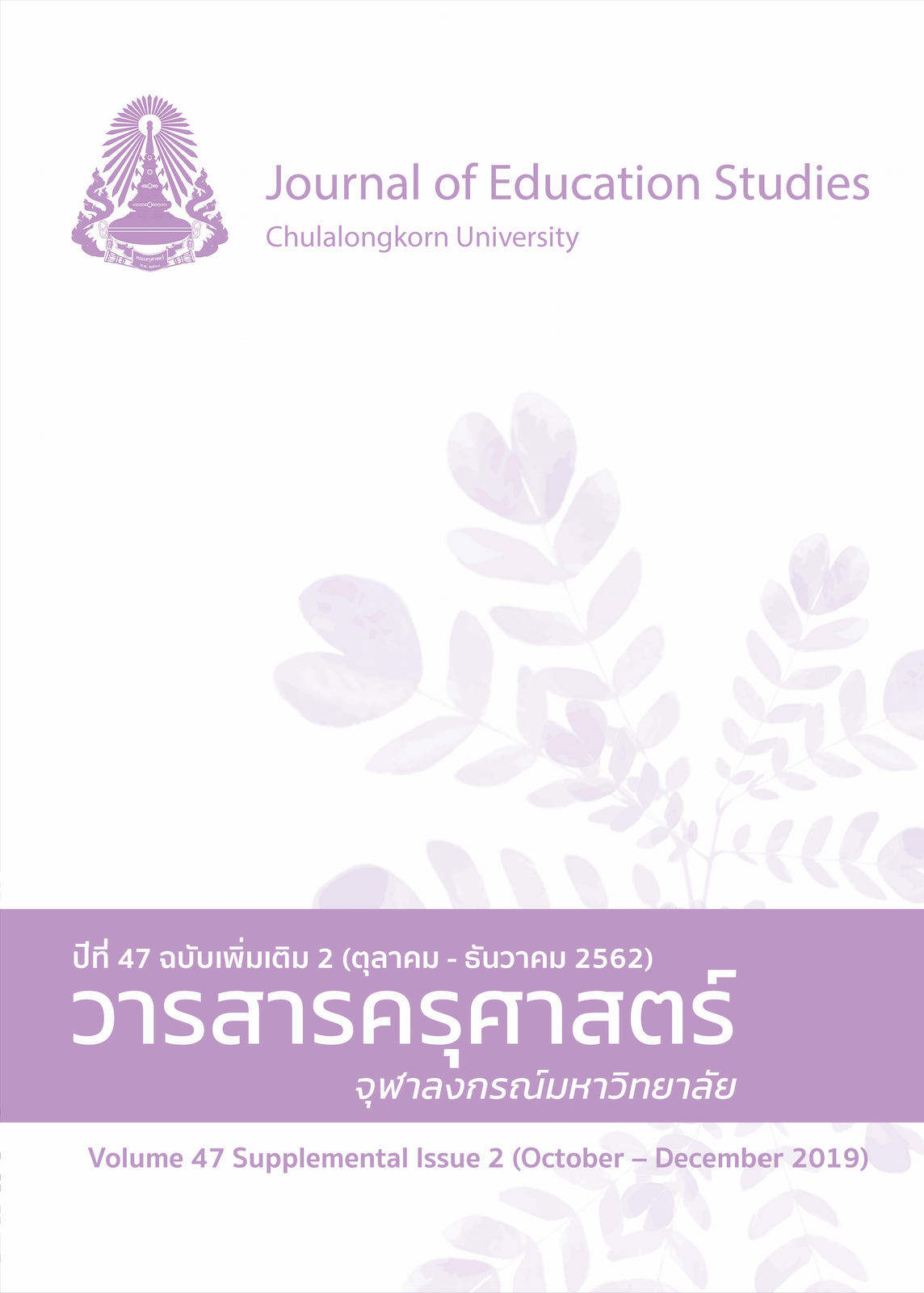A Lifelong Education Management Model for Delveloping Work Skills of Thai Workforce for a Manufacturing Workplace
Keywords:
LIFELONG LEARNING, SELF-DIRECTED LEARNING, BLENDED LEARNING, MANUFACTURING WORKPLACEAbstract
The purposes of this research were to: 1) analyze and synthesize Thai workforce skills at a manufacturing workplace; 2) develop a lifelong education management model in order to improve Thai workforce skills; and 3) study the factors that affect the lifelong education management model in order to improve Thai workforce skills. The research sample of the analysis and synthesis are 24 volunteers drawn from a manufacturing workplace employing a Thai workforce of 400 people. The samples of development model volunteered to participate in 100 hours of activities.
The results of the research were as follows:
- 1. Thai workforce skills analysis revealed the 3 highest scores related to work skills required for the manufacturing workplace are the usage of computer and technology skills, safety operation skills, and intra-organization communication skills.
- 2. The results further showed that three aspects of Thai workforce skills, which included knowledge, work skills, and the self-directed learning levels, increased at the statistical significance level of 0.5 as a result of the activities carried out during the study.
- 3. The supportive factors included enthusiastic learners, roles of the instructors, self-directed learning media, and supervision of the practices. The obstacle factors of the application of the model included available time for learners’ participation, activity place arrangement, learners’ readiness to access to the network system, and learners’ general readiness.
References
กระทรวงศึกษาธิการ. (2542). พระราชบัญญัติการศึกษาแหงชาติ.พ.ศ. 2542 และที่แก้ไขเพิ่มเติม(ฉบับที่ 2) พ.ศ. 2545. กรุงเทพฯ: โรงพิมพ์คุรุสภาลาดพร้าว.
กระทรวงแรงงาน. (2557). แผนแม่บทด้านแรงงาน พ.ศ. 2555–2559. กรุงเทพฯ: กรมพัฒนาฝีมือแรงงาน.
ใจทิพย์ ณ สงขลา. (2542). การสอนผ่านเครือข่ายเวิลด์ ไวด์ เว็บ. วารสารครุศาสตร์, 27(3), 18-28.
ธนาคารแห่งประเทศไทย. (2557). เศรษฐกิจของประเทศไทย. สืบค้นจาก https://praewasri.wordpress.com/category
ปณิตา วรรณพิรุณ. (2551). การพัฒนารูปแบบการเรียนบนเว็บแบบผสมผสานโดยใช้ปัญหาเป็นหลักเพื่อพัฒนาการคิดอย่างมีวิจารณญาณของนิสิตปริญญาบัณฑิต (วิทยานิพนธ์ปริญญาดุษฎีบัณฑิต).
จุฬาลงกรณ์มหาวิทยาลัย, กรุงเทพมหานคร. สืบค้นจาก https://cuir.car.chula.ac.th/handle/123456789/58733
พัฒนาวดี ชูโต. (2554). โครงการทักษะการทำงานของแรงงาน: มุมมองจากนายจ้าง คนงานและหน่วยงาน ภาครัฐ. สืบค้นจาก https://elibrary.trf.or.th/downloadFull.asp?proid=RDG4410014
พิริยะ ผลพิรุฬห์. (2558). การพัฒนาทักษะฝีมือแรงงานและการฝึกอบรม: กรณีศึกษาภาคอุตสาหกรรมไทย. วารสารพัฒนาการเศรษฐกิจปริทรรศน์, 9(1), 129-152.
รังสรรค์ สุกันทา. (2546). การพัฒนารูปแบบการฝึกอบรมผ่านเว็บแบบมีส่วนร่วมตามแนวคิดการเรียนรู้ด้วย การนำตนเองสำหรับบุคลากรขององค์กรธุรกิจ (วิทยานิพนธ์ปริญญาดุษฎีบัณฑิต). จุฬาลงกรณ์มหาวิทยาลัย, กรุงเทพมหานคร. สืบค้นจาก https://cuir.car.chula.ac.th/handle/12345
ศูนย์บริการทางวิชาการเศรษฐศาสตร์ มหาวิทยาลัยธรรมศาสตร์. (2550). รายงานการศึกษาฉบับสมบูรณ์เรื่อง แนวทางการพัฒนากำลังคนเพื่อรองรับการจัดทำเขตการค้าเสรีเสนอต่อสำนักงานปลัดกระทรวงแรงงาน. กรุงเทพฯ: ศูนย์บริการทางวิชาการเศรษฐศาสตร์ มหาวิทยาลัยธรรมศาสตร์.
สุชาติ ประสิทธิ์รัฐสินธุ์. (2546). การใช้สถิติในงานวิจัยอย่างถูกต้องและได้มาตรฐานสากล. กรุงเทพ: โรงพิมพ์สามลดา.
สุวิมล ว่องวาณิช. (2546). แนวทางการให้คำปรึกษาวิทยานิพนธ์. กรุงเทพมหานคร: สำนักพิมพ์แห่งจุฬาลงกรณ์มหาวิทยาลัย.
สำนักงานคณะกรรมการพัฒนาการเศรษฐกิจและสังคมแห่งชาติ. (2555). ภาวะสังคมไทยและภาพรวมปี 2554. สืบค้นจาก https://www.nesdb.go.th
อัมพิกา ไกรฤทธิ์. (2541). การบริหารการผลผลิตในกลุ่มอุตสาหกรรมชิ้นส่วนยานยนต์เพื่ออนาคต. กรุงเทพฯ: มปท.
อาชัญญา รัตนอุบล. (2550). การเรียนรู้และพัฒนาการของผู้ใหญ่. กรุงเทพฯ: สำนักพิมพ์แห่งจุฬาลงกรณ์มหาวิทยาลัย.
อาชัญญา รัตนอุบล. (2551). การเรียนรู้ในสถานประกอบการ. สืบค้นจาก https://portal.edu.chula.ac.th/nfed1/assets//Archanya_Business.pdf
อาชัญญา รัตนอุบล. (2556). การเรียนรู้ในสถานประกอบการ. สืบค้นจาก https://www.edu.chula.ac.th/nfed/student/article.htm#article1
อำนาจ วัดจินดา. (2553). McKinney’s framework แนวคิดปัจจัย 7 ประการในการประเมินองค์กร. สืบค้นจาก https://www.gracezone.org/index.../81--in-search-of-excellence
ภาษาอังกฤษ
Allen, E., & Seaman, J. (2010). Class differences: Online education in the United States. Retrieved from https://sloanconsortium.org/sites/default/files/class_differences.pdf
Alonso, F., López, G., Manrique, D., & Viñes, J. M. (2005). An instructional model for web based e-learning education with a blended learning process approach. British Journal of Educational Technology, 36(2), 217-235.
Barrows, H. S., & Tamblyn, R. M. (1980). Problem-based learning: An approach to medical education. New York: Springer Publishing Company.
Dave, R. H. (1973). Lifelong learning and the school curriculum. Paris: UNESCO.
Dowling, J., & Godfrey, J. (2003). Do hybrid flexible delivery teaching methods improve accounting students’ learning outcomes?. Retrieved from https://www.sciepub.com/reference/24348
Driscoll, M. (2002). Blended Learning: let’s get beyond the hype. Retrieved from https://elearningmag.com/ltimagazine
Field, L. (1991). Skilling Australia. Melbourne: Longman Cheshire Pty.
Knowles, M. S. (1975). Self-directed learning: Guide for learner and teacher. Chicago, IL: Follett Publishing Company.
Meier, D. (2000). The accelerated learning handbook: A creative guide to designing and delivering faster, more effective training programs. NewYork: McGraw Hill.
Vygotsky, L. S. (1997). The historical meaning of the crisis in psychology: A methodological Investigation. New York, NY: Springer Publishing Company.
Yamane, T. (1973). Statistics: An introductory analysis. New York: Harper and Row.
Yasin, M. J., & Mustapha, R. (2007). Workplace learning: Malaysia's experience. Innsbruck: Innsbruck University Press.




